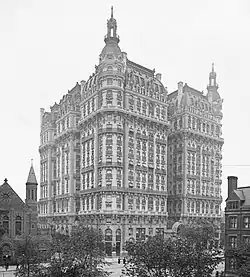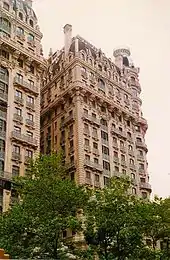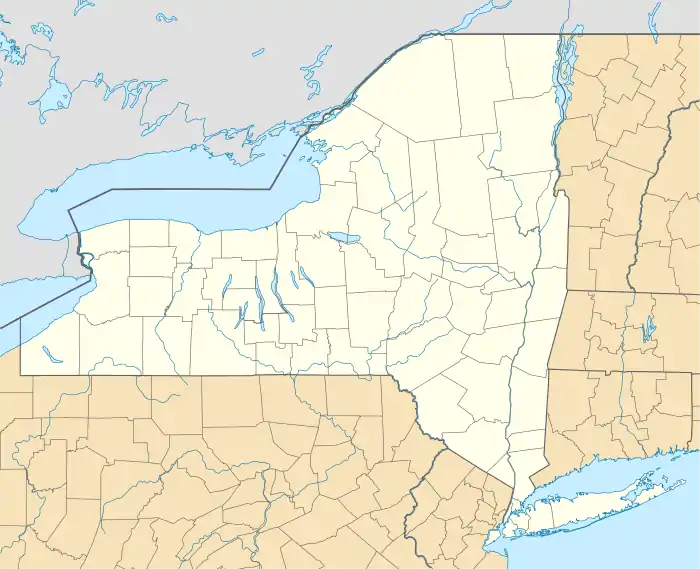The Ansonia
The Ansonia is a building on the Upper West Side of New York City, located at 2109 Broadway, between West 73rd and West 74th Streets. It was originally built as a residential hotel by William Earle Dodge Stokes, the Phelps-Dodge copper heir and shareholder in the Ansonia Clock Company, and it was named for his grandfather, the industrialist Anson Greene Phelps. In 1897, Stokes commissioned French architect Paul Emile Duboy to design the grandest hotel in Manhattan.[2]
Ansonia Hotel | |
 The Ansonia Hotel on Broadway at the intersection with Amsterdam Avenue (image from 1905) | |
| Location | 2101–2119 Broadway, New York, New York |
|---|---|
| Coordinates | 40°46′48″N 73°58′57″W |
| Area | less than one acre |
| Built | 1899-1904 |
| Architect | Duboy, Paul E.M. |
| Architectural style | Beaux Arts |
| NRHP reference No. | 80002665[1] |
| Significant dates | |
| Added to NRHP | January 10, 1980 |
| Designated NYCL | March 14, 1972 |
Stokes would list himself as "architect-in-chief" for the project and hired Duboy, a sculptor who designed and made the ornamental sculptures on the Soldiers' and Sailors' Monument, to draw up the plans. New Orleans architect Martin Shepard served as draftsman and assistant superintendent of construction on the project.[3] The assignee of the contractor proceed against Stokes in 1907, suing for $90,000. But Stokes would defend himself, explaining that Duboy was in an insane asylum in Paris, and it was his belief that he was insane when, in 1903, he signed the final certificate on the plans, and should not have been making commitments in Stokes's name concerning the hotel.[4][5]
In what might be the earliest harbinger of the current developments in urban farming,[6] Stokes established a small farm on the roof of the hotel, where he kept farm animals next to his personal apartment. There was a cattle elevator, which enabled dairy cows to be stabled on the roof.[7]
Stokes had a Utopian vision for the Ansonia—that it could be self-sufficient, or at least contribute to its own support—which led to perhaps the strangest New York apartment amenity ever. "The farm on the roof," Weddie Stokes wrote years later, "included about 500 chickens, many ducks, about six goats and a small bear." Every day, a bellhop delivered free fresh eggs to all the tenants, and any surplus was sold cheaply to the public in the basement arcade. Not much about this feature charmed the city fathers, however, and in 1907, the Department of Health shut down the farm in the sky.[8]
History
The Ansonia was a residential hotel. The residents lived in "luxurious" apartments with multiple bedrooms, parlors, libraries, and formal dining rooms that were often round or oval. Apartments featured views north and south along Broadway, high ceilings, "elegant" moldings, and bay windows. There were three thousand rooms. Arrangements could be made to rent a suite varying in size from a room and a bath to thirty rooms. Some of these suites were rented for $14,000 a year,[9] the equivalent of more than $400,000 in 2018. The smaller units, with one bedroom, parlor, and bath, lacked kitchens. There was a central kitchen and serving kitchens on every floor, so that the residents could enjoy the services of professional chefs while dining in their own apartments. Besides the usual array of tearooms, restaurants, and a grand ballroom, the Ansonia had Turkish baths and a lobby fountain with live seals.
Erected between 1899 and 1904, it was the largest residential hotel of its day and the first air-conditioned hotel in New York. The building has an eighteen-story steel-frame structure. The exterior is decorated in the Beaux-Art style with a Parisian style mansard roof. The Ansonia features round corner-towers or turrets and an open stairwell that sweeps up to a domed skylight.

The building's copper cornices were removed during World War II and melted down for the war effort.[10]
The Ansonia has had many celebrated residents, including baseball player Babe Ruth; writer Theodore Dreiser, in 1912; the leader of the Bahá'í Faith `Abdu'l-Bahá; Nobel prize winner in literature Isaac Bashevitz Singer; conductor Arturo Toscanini; composer Igor Stravinsky; fashion designer Koos van den Akker; and Italian tenor Enrico Caruso.
By the mid-twentieth-century, the grand apartments had mostly been divided into studios and one-bedroom units, almost all of which retained their original architectural detail. After a short debate in the 1960s, a proposal to demolish the building was fought off by its many musical and artistic residents.
From 1977 until 1980, The Ansonia Hotel's basement was home to Plato's Retreat, an open door swinger sex club. Prior to Plato's Retreat, the building housed the Continental Baths, operated by Steve Ostrow, a gay bathhouse where Bette Midler provided musical entertainment early in her career, with Barry Manilow as her accompanist.[11][12][13]
In 1980, the building was inducted to the National Register of Historic Places.[1]
In 1992, the Ansonia was converted to a condominium apartment building with 430 apartments. By 2007, most of the rent-controlled apartment tenants had moved out, and the small apartments were sold to buyers who purchased clusters of small apartments and threw them together to recreate grand apartments.
The Ansonia is home to part of the New York campus of the American Musical and Dramatic Academy.
Scandals
_Godman_-1919.jpg.webp)
- In 1916, the Ansonia was the scene of a blackmail plot. Edward R. West, Vice President of the C. D. Gregg Tea and Coffee Company of Chicago, had checked into the hotel with a woman known to him as Alice Williams. Alice Williams was an alias of Helen Godman, also known as "Buda" Godman, who acted as the "lure" for a blackmail gang based in Chicago. West and Godman were together in their room at The Ansonia when two male members of the gang, impersonating Federal law enforcement agents, entered the room and "arrested" West for violation of the Mann Act.[14] After transporting West and Godman back to Chicago, West was coerced into paying the two "agents" $15,000 in order to avoid prosecution, and avoid embarrassment or soiling the reputation of "Alice." West reported the incident after becoming suspicious that not everything was as it seemed. Several of the male blackmailers earned prison terms, but "Buda" Godman was released on $10,000 bail.[15] Skipping bail, she disappeared for many years, but was eventually caught and charged for trying to fence the Glemby Jewels taken in a 1932 robbery.[16]
- A key player in the 1919 Black Sox Scandal, the Chicago White Sox first baseman Chick Gandil had an apartment at the Ansonia. According to Eliot Asinof, in his book Eight Men Out, Gandil held a meeting in the Ansonia apartment with his White Sox teammates to recruit them for the scheme to intentionally lose the 1919 World Series.
- Willie Sutton, the bank robber, was arrested for the sixth time (of eight) two days before Thanksgiving, 1930, while having breakfast at Childs Restaurant in the Ansonia.[17]
In popular culture
- In the film Three Days of the Condor (1975), the alley behind the hotel is used as a rendezvous for Robert Redford's character, which becomes an ambush for a failed assassination.
- In the film The Sunshine Boys (1975), Walter Matthau's character has an apartment in the building.
- It was featured in the film Single White Female (1992) starring Bridget Fonda and Jennifer Jason Leigh.
- It was featured in the film Don't Say a Word (2001) as the residence of the main character, played by Michael Douglas.
- It was featured in the film My Super Ex-Girlfriend (2006) starring Uma Thurman and Luke Wilson.
- The Ansonia was the basis for the fictional Balmoral building in Jed Rubenfeld's literary novel The Interpretation of Murder (2006).
- In the film Perfect Stranger (2007), Halle Berry plays a news reporter who lives in a "professionally decorated $4-million condo in the lavish Ansonia building on the Upper West Side."[18]
- The building was used in the 2012 TV show 666 Park Avenue.[19]
- In the film The Immigrant (2013), set in 1920s' New York City, Bruno says to Ewa, after taking her to a shabby apartment, "Well it ain't the Ansonia, but it is comfortable."
Notable residents
- Italian baritone Giuseppe Danise
- Fashion photographer Deborah Turbeville
- Lauritz Melchior (famed Metropolitan Opera tenor who "practiced archery in the 110-foot (34 m) corridors"[20])
- Lily Pons
- Martin Charles Ansorge (1882–1967), United States Representative from New York[21]
- Stage actor James T. Powers
- George Herman "Babe" Ruth (and family)
- Maestro Vincent La Selva (and family) world renowned conductor and founder of the New York Grand Opera. Awarded the Handel Medallion by former Mayor Giuliani.
Education
Children living in the Ansonia are eligible to attend schools run by the New York City Department of Education. The building is zoned to P.S. 87, the William Sherman School, but it is unzoned for middle school. Residents of the Ansonia may contact Region 10 to determine the middle-school assignments.
See also
- List of former hotels in Manhattan
- Ansonia Apartments, Los Angeles, built 1916
- National Register of Historic Places listings in Manhattan below 14th Street
- List of New York City Designated Landmarks in Manhattan below 14th Street
References
- "National Register Information System". National Register of Historic Places. National Park Service. March 13, 2009.
- Gray, Christopher (August 28, 2005). "A West Side Developer's Other Side". The New York Times - Real Estate Section. Retrieved October 17, 2018.
- Shepard, Martin. Undated resume. Martin Shepard Office Records, Southeastern Architectural Archive, Special Collections Division, Tulane University Libraries.
- A West Side Developer's Other Side = New York Times – August 28, 2005
- "Summary: Contesting a final Certificate on the Ground of Insanity". The American Architect and Building News. New York: James R. Osgood & Co. (published 1907). 91 (1628): 198. May 18, 1907. Retrieved September 15, 2018.
- "5 Urban Design Proposals for 3D City Farms". Weburbanist.com. March 24, 2008. Retrieved December 21, 2009.
- "Cultural Resource Information System (CRIS)" (Searchable database). New York State Office of Parks, Recreation and Historic Preservation. Retrieved March 1, 2016. Note: This includes David J. Framberger and Joan R. Olshansky (July 1979). "National Register of Historic Places Registration Form: Ansonia Hotel" (PDF). Retrieved March 1, 2016. and Accompanying nine photographs
- The Building of the Upper West Side = New York Magazine – May 21, 2005
- Waugh, W. Wallace (March 7, 1903). "Personally Conducted on Land and Sea". Boston Home Journal: An Illustrated Paper of Society and Travel. 59 (10): 20. Retrieved October 3, 2018.
- "The City, From Wartime Grit to Modern Soullessness," New York Times, Jan 29, 2010,
- Fons, Mary K. (September 2005). "Inside the Ansonia". The Cooperator. Retrieved December 2, 2007.
- Gaines, Steven (2005). The Sky's the Limit: Passion and Property in Manhattan. New York: Little, Brown and Company. p. 197. ISBN 0-316-60851-3.
- Golubski, Suzanne; Kappstatter, Bob. "Swinging doors shut: City probe KO's Plato's". Daily News. Archived from the original on September 27, 2007. Retrieved November 8, 2007.
- "TWO ADMIT BLACKMAIL.; Buda Godman and Man Held in $10,000 Ball". The New York Times. November 9, 1916. Retrieved May 25, 2010.
- McLaren, A. (2002). Sexual blackmail: A modern history. Cambridge, Mass.:Harvard University Press. p.90
- James, M. (1943). Biography of a business, 1792–1942: Insurance Company of North America. Indianapolis: Bobbs-Merrill. p.299
- Sutton, Willie. "Willie Sutton's Arrests". www.williesutton.com. Retrieved July 17, 2013.
- Hunter, Stephen (April 13, 2007). "'Perfect Stranger': Not Thrilled To Meet You". The Washington Post. Retrieved May 25, 2010.
- Ekizian, John (August 19, 2012). "Iconic Ansonia stars in '666 Park Ave'". New York Post. Retrieved October 2, 2012.
- Peter Salwen. Upper West Side Story: A History and Guide. New York: Abbeville Press, 1989, p. 142. ISBN 1558594299.
- "Martin Ansorge, Was In Congress. Co-author Of Bill To Create Port Authority Is Dead". New York Times. February 6, 1967.
External links
| Wikimedia Commons has media related to The Ansonia. |
- History and pictures The City Review.com
- Steven Gaines, "The Building of the Upper West Side," New York Magazine, May 21, 2005.
- Mary K. Fons, "Inside the Ansonia, A New York Classic," The Cooperator, September 2005.





